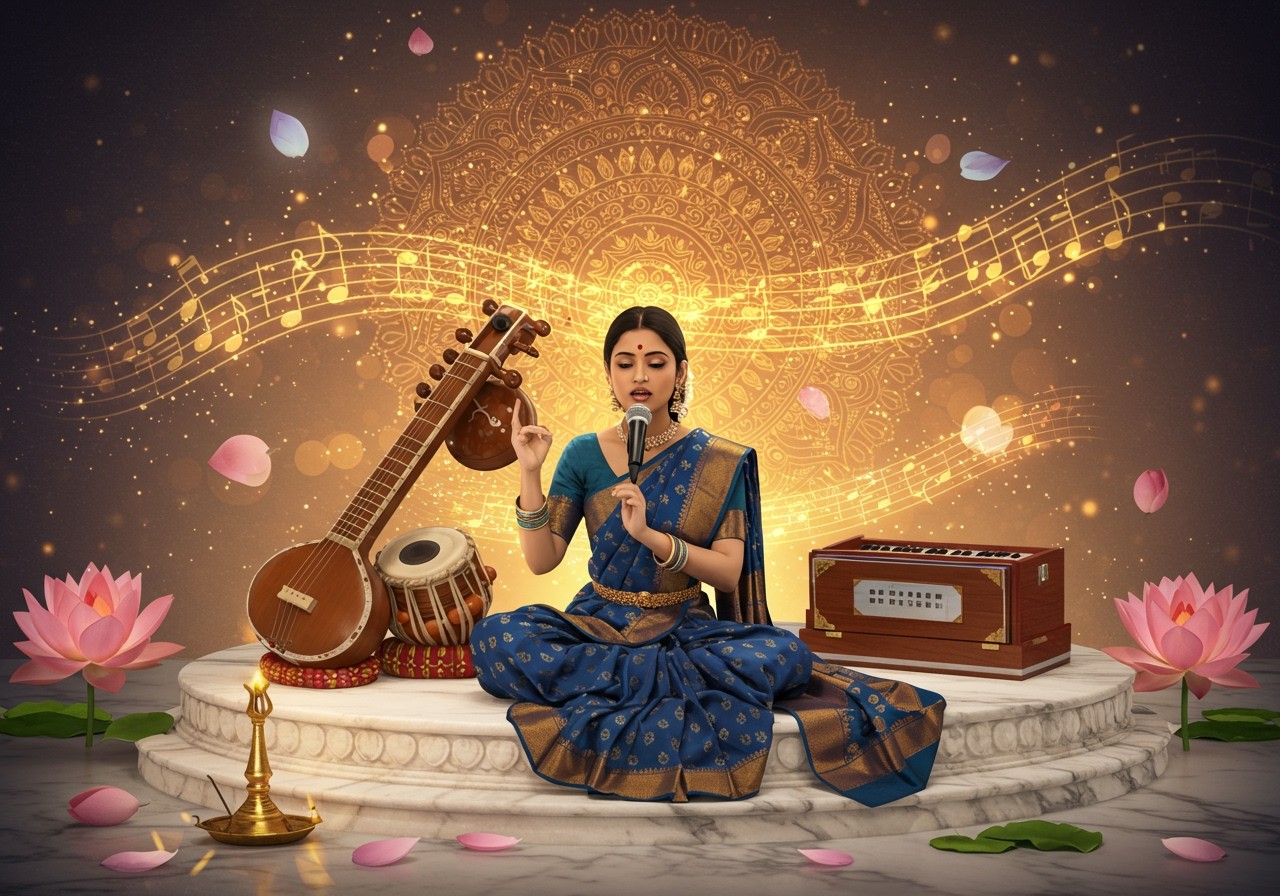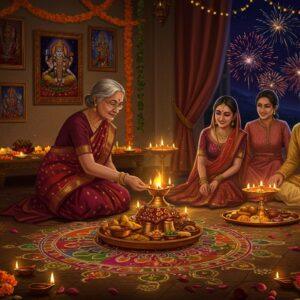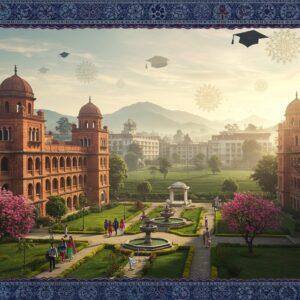
Indian Classical Music is a profound tradition, deeply interwoven with spirituality, emotion, and our rich cultural history. At its core lie ragas, the melodic frameworks that give this genre its unique character. In today’s world, where digital platforms have opened up new avenues for experiencing our heritage, there’s a growing interest among audiences – individuals who cherish tradition yet appreciate the convenience of online exploration. This resurgence highlights the importance of authentic musical experiences in preserving and celebrating our cultural legacy.
Delving into the Essence of Ragas
Ragas are more than just musical scales; they are intricate combinations of notes governed by specific rules, meticulously crafted to evoke distinct emotions. Each raga possesses an ‘Arohana’ (ascending notes) and ‘Avarohana’ (descending notes), creating a melodic conversation that often aligns with particular times of the day or seasons. The ‘Vadi’ (most prominent note) and ‘Samvadi’ (second most prominent note) act as pillars, defining the raga’s unique character. Whether employed in vocal performances or instrumental compositions, ragas offer artists a vast canvas for interpretative freedom, allowing them to express themselves within a structured yet flexible framework.
The Diverse Tapestry of Raga Types
The world of ragas is a vibrant tapestry woven with various forms, each carrying its unique essence. ‘Janaka’ ragas serve as parent scales, the foundation upon which ‘Janya’ ragas are derived, expanding the melodic possibilities. This rich diversity empowers musicians to select a raga that perfectly complements the desired mood or occasion. Morning ragas, such as the serene ‘Bhairav’, offer a calming start to the day, while evening ragas, like the tranquil ‘Yaman’, evoke a sense of peace as the day draws to a close. Regional variations further enrich this tradition, with Hindustani ragas from North India and Carnatic ragas from South India each reflecting their distinct cultural roots. Even within these styles, interpretations of the same raga can differ, adding layers of complexity and beauty. This dynamic interplay ensures that Indian classical music remains a living, evolving art form.
Thinking about adding a touch of traditional decor to your home? Check out our beautiful selection of decorative items at Poojn.in.
Emotional Resonance and the Meaning of Ragas
Ragas possess a unique power to convey deep emotions, capturing the essence of human experience. The concept of ‘Rasa’ encapsulates the aesthetic experience a raga aims to evoke. Each raga resonates with specific emotions – joy, love, peace, contemplation, or even melancholy – creating a profound connection with the listener. This emotional depth sets Indian classical music apart, transforming it into a language of the soul.
Ragas often find their place in meditation and spiritual practices, serving as a gateway to introspection. They provide a melodic path for individuals to connect with their inner selves, fostering a sense of peace and tranquility. Artists often infuse their performances with personal touches, blending tradition with innovation while maintaining deep respect for the raga’s essence. This approach keeps the music relevant and accessible, resonating with contemporary audiences while honoring its timeless roots. Find everything you need for your puja room and spiritual practice at Poojn.in.
Embarking on Your Raga Journey: A Beginner’s Guide
Starting your journey with ragas can be an enriching experience. Begin with simpler ragas like ‘Yaman’ or ‘Bhairav’, which are easier to grasp for newcomers. Immersing yourself in various performances by renowned artists will cultivate your ear for the nuances of different interpretations. Traditionally, learning under the guidance of a guru is considered essential, as this oral transmission preserves the authenticity and depth of understanding passed down through generations. However, for those seeking convenience and accessibility, online tutorials and workshops now offer valuable resources. Music apps also cater to modern learners, providing a convenient way to explore the world of ragas.
Enhance your practice with authentic instruments and puja items. Explore our collection of clay diyas, incense sticks, and other puja essentials.
Ragas in the Contemporary Soundscape
The influence of ragas extends beyond traditional boundaries, enriching various contemporary genres. In film music, they add emotional depth to storytelling, enhancing the narrative’s impact. Fusion and world music collaborations between Indian classical musicians and global artists create exciting new dialogues, expanding the raga repertoire and introducing it to wider audiences. In therapeutic contexts, ragas play a valuable role in music therapy sessions, facilitating emotional healing and stress reduction. Their ability to transcend traditional boundaries underscores their enduring relevance in our globalized world.
Embracing the Melody: A Deeper Connection
Embarking on the journey of understanding ragas opens a world rich with tradition, emotion, and cultural depth. These melodies, steeped in history, offer more than just music; they provide a connection to the soul and a bridge to our cultural heritage. By exploring ragas, you immerse yourself in a tradition that spans generations, each note a step closer to inner peace and understanding. Whether you choose to learn through a guru or explore online resources, the beauty of ragas awaits you, inviting you to experience a musical journey that is both personal and universal. As you embrace the melody of ragas, you not only appreciate music’s timeless beauty but also carry forward a treasured tradition that resonates deeply with the heart.
Your Musical Journey with Poojn.in
At Poojn.in, we understand the deep connection between music and spirituality, particularly in the worship of Lord Shiva, revered as Nataraja, the Lord of Dance. We offer a curated selection of items to enhance your musical worship and practice:
- Pure copper bells (ghanta): With their clear, resonant tones, these bells are ideal for pitch practice and creating a sacred atmosphere. Browse our selection.
- Traditional damru drums: Used in Shiva worship and rhythm training, the damru represents the primal sound of creation.
- Brass cymbals (manjira): Essential for keeping taal during bhajans and other devotional music.
- Puja thalis with musical instruments: Enhance your Shiva aarti with a complete thali including musical accompaniments.
- Complete Shiva puja sets: Everything you need for a reverent Shiva puja, including musical instruments.
We deliver these authentic ritual items across India, bringing the sacred sounds of devotion right to your doorstep. Quality and authenticity are assured, with all products verified by expert pandits. Explore our store-only exclusives.
Learning Indian Classical Music: A Step-by-Step Guide
Ready to embark on your musical journey? Here’s a guide to help you navigate the beautiful world of Indian classical music:
1. Building a Strong Foundation
- Swaras (Musical Notes): Begin by familiarizing yourself with the seven swaras (Sa, Re, Ga, Ma, Pa, Dha, Ni). Practice recognizing and singing these notes accurately to build a solid foundation.
- Ragas: Learn the basics of ragas and their structure. A raga is a melodic framework that forms the basis of improvisation and composition in Indian classical music. Explore simple ragas initially.
- Talas (Rhythmic Cycles): Understanding and practicing talas is crucial for developing a sense of rhythm. Start with fundamental talas like Teental (16 beats) and Jhaptaal (10 beats). Using a tabla app or practicing with a live tabla player can significantly improve your rhythmic skills.
2. Vocal Training (for Vocal Music)
- Riyaz (Practice): Consistent practice is the cornerstone of vocal training. Implement a disciplined routine:
- Morning: Focus on long-held notes (Aalaap) to develop breath control and vocal strength.
- Midday: Dedicate time to raga-based exercises and improvisations.
- Evening: Sing compositions (Bandish) in different tempos to enhance expression and control.
- Self-Assessment: Regularly record yourself singing and listen back to track your progress. This helps identify areas for improvement and refine your technique.
3. Choosing and Mastering Your Instrument
- Selecting an Instrument: Choose an instrument that resonates with you and aligns with your musical aspirations.
- Fundamental Techniques: Focus on mastering the fundamental techniques specific to your chosen instrument. This provides a solid base for advanced learning.
- Practice Aids: Utilize tools like metronomes and tanpura apps to maintain accurate rhythm and pitch during practice. Apps like “TaalMala” and “Riyaz” offer automated accompaniments for raga and tala practice.
4. Finding a Guru (Teacher)
- Guidance from a Guru: Learning from a skilled and experienced guru is invaluable in Indian classical music. A guru provides personalized instruction, feedback, and traditional knowledge.
- Finding a Teacher: Research teachers in your local area or explore online options. Seek recommendations from fellow musicians or cultural institutions.
- Online Learning: If local options are limited, consider online classes. Platforms like Zoom or Skype facilitate online learning with teachers worldwide. Websites like TakeLessons and Preply offer connections to music teachers specializing in Indian classical instruments.
- Institutions: Many music schools and cultural institutions offer structured courses in Indian classical music.
5. Immersing Yourself in the Music
- Active Listening: Immerse yourself in the world of Indian classical music by listening to recordings of legendary musicians like Pandit Bhimsen Joshi, Ustad Amir Khan, and Kishori Amonkar. Explore different interpretations of ragas and develop your musical ear.
- Live Performances: Attend live concerts or online performances to experience the magic of real-time improvisation and raga expressions.
- Instrumental Interpretations: Listen to the same raga played on different instruments to gain a broader understanding of its melodic possibilities.
6. Engaging with the Musical Community
- Active Participation: Engage with the Indian classical music community to broaden your horizons and connect with fellow enthusiasts.
- Concerts and Workshops: Attending concerts and workshops provides inspiration and deepens your understanding of the music. Interact with artists and fellow attendees to learn from their experiences.
- Music Groups and Forums: Join local or online music groups and forums to connect with other musicians, share insights, and learn about upcoming events.
- Collaboration: Collaborating with other musicians offers a rewarding way to enhance your musical skills and expand your creative expression.
7. Utilizing Learning Resources
- Online Resources: Platforms like YouTube offer a wealth of instructional videos and masterclasses by renowned musicians. Explore online courses on websites like Coursera and Udemy.
- Books and Tutorials: Seek out books and tutorials specific to your chosen instrument or vocal style. These resources provide structured learning and valuable insights into technique and theory.


